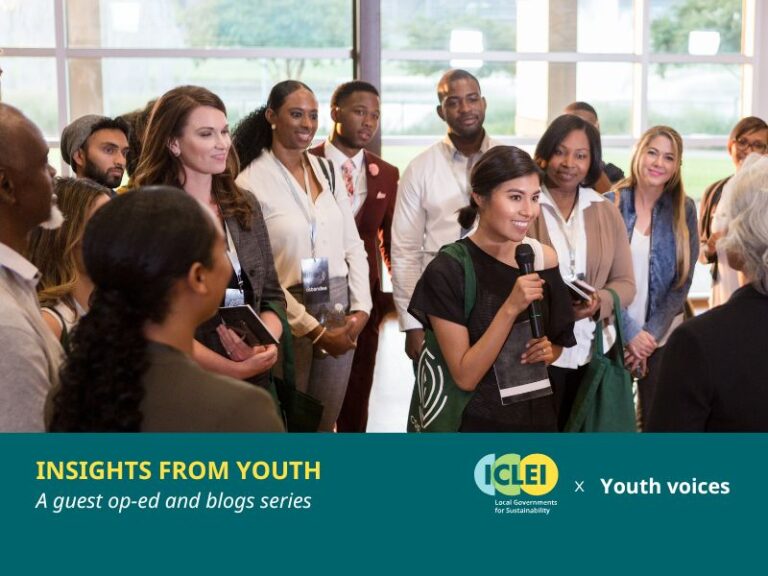Cities empowering youth for climate action: Lessons to replicate (and how to do it)
International Youth Day on 12 August recognizes young people as drivers of change. How can local and regional governments effectively engage them? From energy mentoring programs and youth councils to video campaigns, here are cases for inspiration on how ICLEI Members include youth voices in climate action and a checklist for city leaders to get youth in green action on board.
This blog was written by Amina Omar Elsherif and edited by Barbara Riedemann from ICLEI World Secretariat.
“Adults look at the world through fears and problems rather than through hopes and dreams.” This is one of the comments that the city of Espoo, Finland, drew from its Future Mentors Programme workshops. It is a reverse mentoring program in which young mentors share their ideas related to their hometown with a mentee, a local decision-maker. And the climate crisis is precisely the most recurring concern among the city’s youth. Also in Finland, Turku has a youth energy mentoring program and has spearheaded initiatives to engage the young in its ambitious goal of becoming climate neutral by 2029. For example, its 2020 campaign invited young people to make creative videos telling their best everyday climate tips, and the city’s residents themselves selected the winner.
Under the slogan Green Skills for Youth: Towards a Sustainable World, this 12 August, the United Nations celebrates International Youth Day 2023. According to them, half of the planet’s inhabitants are 30 years old or younger, and they will represent 57% by the end of 2030. In addition, 69% of the total population believes that if young people had more say in their institutions, political systems, and decision-making would improve and be more inclusive. Regarding what is yet to come, the UN states that a similar number of people believe in a better future. Of this group, those between 15 and 17 years old are the most optimistic in foreseeing better times.
In recent years, this age group is becoming increasingly involved and vocal about climate action. Whether taking to the streets in premeditated or spontaneous demonstrations, actively participating in exchanges, forums, and programs, or raising their voice in the digital world. However, the gap between youth action to combat climate change and decision-making in the political and institutional world persists. And this is where the role of local and regional governments is crucial. But how can they effectively engage youth? How can they benefit from the youth’s interests and experiences?
As in Finland, some U.S. cities have found an answer. In Olympia, youth climate action clubs and even non-climate-focused youth groups are involved in developing the city’s new Climate Action Plan. In Boise, a Youth Climate Action Council provides tools and guidance for concrete work within the local community. In San Antonio, the Mayor’s Youth Engagement Council for Climate Initiatives offers young people a chance to participate in politics toward climate action.
Cascais in Portugal involves youth in their initiative to meet Paris Agreement goals through a Youth Participatory Budget, and the AdaptCascais Fund call for proposals. The winning ideas can receive up to €3,000 for implementation, such as training fishermen on proper plastic waste disposal, an exhibition of marine litter in the city’s bay, and a tree planting campaign for each young person who joins the green action. They also offer a youth empowerment program with courses, workshops, and field experiences.
Unlocking the Power of Youth: A Checklist for Local and Regional Governments
The invitation is to subnational governments of all sizes and types to be inspired and implement engagement strategies that work for their context. How to do it? Where to begin? To help local leaders, ICLEI with the support of the Official Children and Youth Constituency (YOUNGO), Student Energy and UNICEF have developed this checklist to address the need for clear and practical steps for local governments to engage with youth in their communities.
The checklist has three main sections: Advocacy, Governance, and Knowledge Sharing & Capacity Development. These sections align with the three pillars outlined in ICLEI’s Vision on Youth Engagement in Global Climate Action released at COP27. Under each section, there are two main categories: Specific actions outlined in the “What to do?” category, and suggestions for key performance indicators (KPIs) listed under the “How to measure impact?” category. Additionally, the guide reviews the cases of the cities described above.
This hands-on, living document also aims to fill the youth engagement gaps highlighted by the Youth Stocktake event, organized in June at the Bonn Climate Change Conference (SB58) by YOUNGO. A similar progress assessment on climate action since the Paris Agreement is underway at the global level (through the UN Global Stocktake) and at the local level (through the #Stocktake4ClimateEmergency initiative led by the Local Governments and Municipal Authorities Constituency).
To amplify the youth voice in the latter process, the LGMA Constituency and YOUNGO have initiated a synergistic approach between #Stocktake4ClimateEmergency events and Local Conference of Youth (LCOY) Sessions when hosted in the same city/region. By bringing together these platforms, young activists, local leaders, and global stakeholders can exchange ideas, experiences, and strategies to address climate challenges effectively. All these contributions will then be reported to the United Nations Framework Convention on Climate Change (UNFCCC) at COP28 in Dubai, providing an essential youth perspective in shaping global climate policy.







